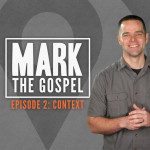The location of Jesus’ botched healing in the Gospel of Mark tells us a great deal about its meaning.
There’s this episode in Mark’s gospel which you might find particularly puzzling. Here it is in chapter 8:
And they came to Bethsaida. And they brought a blind man to Jesus and implored Him to touch him. Taking the blind man by the hand, He brought him out of the village; and after spitting on his eyes and laying His hands on him, He asked him, “Do you see anything?” And he looked up and said, “I see men, for I see them like trees, walking around.” Then again He laid His hands on his eyes; and he looked intently and was restored, and began to see everything clearly.
Ok. Besides the spit and trees, which are odd enough, what’s the deal with this two-part healing? In Mark, Jesus can raise the dead and overpower a legion of demons. But he botches this man’s healing on the first try? What’s the point?
This is a problem in reading Mark’s gospel. Short pithy episodes like this form the bulk of the narrative and can often seem quite random. As if Mark is simply stringing together every amazing Jesus story he knows. Jesus did this and then he did this and then he did this. Our modern bibles actually encourage us to read Mark this way, chapter and verse divisions and section titles break down the text, causing us to to consider these stories in isolation. But these episodes are from random. They’re skillfully arranged.
You’ve heard the mantra in real estate, right? “location, location, location.” Well in interpretation, it’s “context, context context”
The location of Mark’s stories actually tells us a great deal about their meaning.
Look at the episode just before this two-part healing.
In the two previous chapters, Jesus spent a great deal of time privately training his disciples. On their first mission he instructed them to carry no bread. Then he showed them how they could feed 5,000 and yet again 4000 with a few loaves of bread. And now he finds them totally misunderstanding his figurative teaching about the leaven of the Pharisees, wondering if they should have brought bread.
He tears into them. Are you so stupid?
“Why are you discussing the fact that you have no bread? Are you’re hearts hardened? Having eyes do you not see and having ears do you not hear?” Do you not yet understand?”
You see that? Jesus has just linked blindness with a lack of understanding. Encountering a blind man in the very next story is not by accident. His blindness illustrates the disciples lack of understanding. And his partial healing their partially opened eyes.
Look at this. The disciples actually get something right in the following episode. Jesus asks them, the one question everyone’s been wondering, “Who do you think I am” “You are the Christ” The King! Peter says.
They see it! But a faulty vision persists.
When Jesus next tells them that He, the Christ, is going to be rejected and killed, Peter rebukes him. That’s not at all what he meant by his answer. The student is now correcting the teacher. We find this sort of blind pride again a chapter later. When Jesus tells the disciples again that he’s going to be killed, they immediately start arguing with one another about which of them is the greatest. And still it persists a chapter after that. This time, to make sure they don’t miss the point, Jesus not only tells them that he’s going to be killed, but mocked, spit upon, and whipped too. To which James and John respond by asking if they can have the seats closest to his throne.
You can just see the dumbstruck expression on Jesus face. “You don’t know what you are asking for,” Jesus says.
Not at all.
They’re stupid. They don’t see. Though they can see that Jesus is the Christ they don’t at all understand what that means. They persist in thinking that being close to Jesus will some how make them great in the eyes of the world.
We find this pattern repeated three times in Mark 8-10. Jesus predicts his death and the disciples express some ironic pride. Which in turn leads Jesus to correct them through a paradoxical teaching. Up is down and down is up. To save your life is to lose and to lose your life is to save it. To to be first, you must be last. And to be first, you must be the slave of all. To be the Christ, the King, Jesus must suffer and die and for them to be his disciples they must live out that same heartbreaking contradiction.
What’s interesting is that its after the third time, Jesus once again encounters a blind man. The only other blind man in Mark’s gospel. And he cries out something akin to Peter’s earlier confession, calling Jesus “Son of David” heir to the royal throne. This blindman gets it. This time, when Jesus heals the man, there’s no spit. Jesus doesn’t even have to touch him to get him to see.
Opening of the blind eyes of these two men act as bookends around the correction of the disciples view of Jesus, his mission and what it means for them and by extension us.
Though the disciples still don’t get it, as we shall see, at least we should.
See you next time.
















